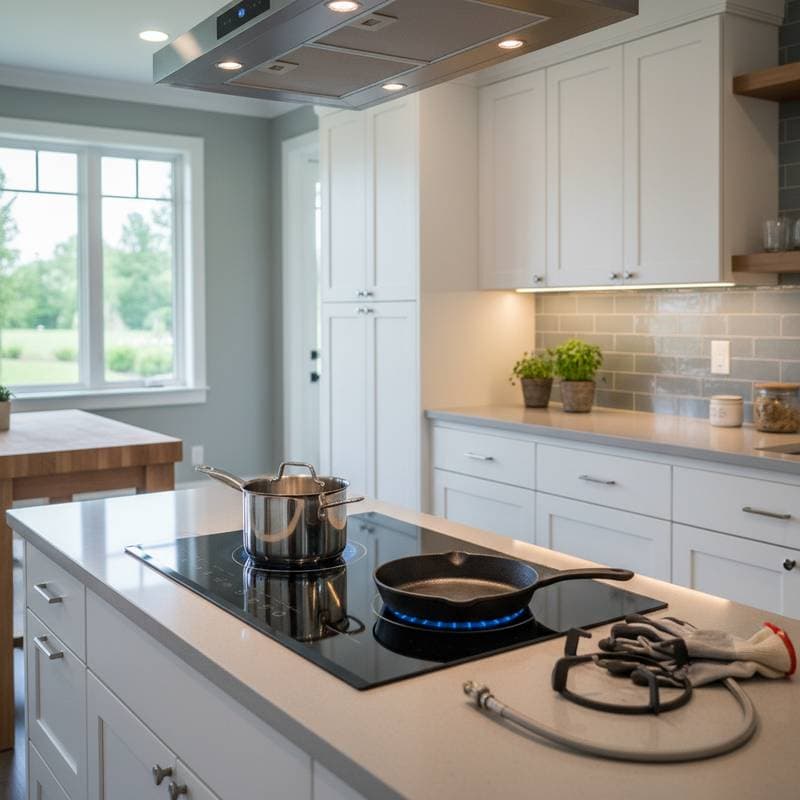Induction Zones: Transition from Gas to Smarter Kitchen Cooking
The modern kitchen serves as more than a functional space. It embodies performance, precision, and personal style. Moving from gas to induction cooking goes beyond selecting an energy source. This change signals a deeper evolution in cooking methods, daily living, and home aesthetics. Induction zones promote a quieter, cleaner approach to meal preparation. They integrate advanced technology with elegant design principles.
10. The Aesthetic of Simplicity
Induction cooktops embody minimalism through their glass-ceramic surfaces, available in finishes like deep graphite or matte black. These surfaces install flush with the countertop, creating a seamless integration. Gas ranges, with their exposed grates and burners, disrupt this flow. In contrast, induction maintains visual continuity. Designers such as Patricia Urquiola and Vincent Van Duysen select induction for open-concept kitchens to preserve architectural serenity. The cooktop functions like an extension of the furniture, harmonizing with materials such as stone, wood, or composites for a sophisticated, understated effect.
9. Performance Rooted in Precision
Induction's appeal extends beyond looks to its core technology. Magnetic fields heat pots and pans directly, keeping the cooktop surface cool. This method provides instant temperature adjustments, rivaling gas responsiveness with added precision. Chefs like Clare Smyth value this control for tasks such as maintaining a delicate simmer for sauces or achieving ideal caramelization on seared scallops. Such accuracy elevates routine cooking and complex recipes alike, delivering consistent results with minimal effort.
8. The Cleaner Way to Cook
Induction supports healthier indoor environments by avoiding gas combustion byproducts like nitrogen dioxide and carbon monoxide. Kitchens stay cooler and air quality improves without these emissions. Cleanup proves simple; a quick wipe suffices to restore the smooth surface. Designers like Kelly Wearstler pair induction with integrated downdraft ventilation. This combination yields a tidy, efficient setup free from bulky hoods.
7. Material Harmony in Modern Kitchens
Without open flames or intense heat, induction allows greater freedom in countertop choices. Materials such as honed marble, soapstone, or quartzite can surround the cooktop without risk. Architects from Studio McGee and Olson Kundig leverage this to craft unified kitchen islands resembling single stone slabs. Pair these with cabinetry in European oak or walnut. The result combines organic warmth with sharp, modern lines.
6. A Smart Approach to Energy
Induction excels in energy transfer, directing nearly all power to the cookware rather than wasting it in the air, as gas often does. This efficiency reduces utility costs for energy-aware households. Modern models incorporate sensors that adapt to pan sizes, optimize zones, and avert overheating. The Bosch 800 Series and Miele KM lines exemplify this, offering professional-grade controls in user-friendly designs. Intelligence drives performance without unnecessary consumption.
5. Rethinking the Soundscape of Cooking
Eliminating gas flames alters the kitchen's auditory experience. No ignition hisses or fuel roars disrupt the space. Instead, subtle magnetic hums and ventilation create a peaceful backdrop. This quietude fosters easier conversations around the island or dining area. Cooking becomes a contemplative activity, enhancing the home's overall sensory balance.
4. Safety and Family Living
Induction prioritizes safety, especially in homes with children. Heating activates only with compatible cookware, minimizing burn risks from the surface itself. Features like child locks, auto shutoff, and heat indicators add layers of protection. The surface cools rapidly post-use. These elements suit multi-generational living, blending style with reliable function. Parents value the quick boil followed by immediate safe removal of pots.
3. The Art of Conversion
Switching to induction demands careful preparation beyond appliance replacement. Electrical upgrades often prove necessary to support the cooktop's power needs. Engage a licensed electrician to reroute from gas lines to dedicated circuits. Consider aligning the switch with broader updates, like refreshed countertops or backsplashes. This approach ensures technical reliability alongside design cohesion.
2. Design Integration and Flexibility
Induction options vary from two-burner compacts to five-zone expanses that accommodate griddles or large pans. Such versatility fits diverse cooking needs and space constraints. In urban apartments, portable single-zone units double as primary and supplemental surfaces. Larger residences benefit from inset modules in stone or stainless steel for bespoke arrangements. Designers like Jean Stoffer and Nate Berkus employ multiple units to form adaptable zones that align with family routines.
1. The Future of Culinary Design
Induction's growth aligns with global pushes for sustainable practices. Municipalities incentivize gas phase-outs, prompting innovative responses from design experts. These kitchens prove that eco-friendliness enhances beauty. Integrate with ambient lighting, natural textures, and silent appliances for a tranquil, effective environment. This fusion of efficiency and form shapes tomorrow's culinary spaces.
Adapting to Induction in Daily Use
After installation, induction integrates seamlessly into routines. Digital interfaces enable exact settings for melting chocolate at low heat or stir-frying at high temperatures. Maintenance requires no disassembly of parts; a simple clean keeps it pristine. Users often explore new techniques, like even-heat sous vide or emulsions, thanks to uniform distribution. The kitchen evolves into a more composed, purposeful area.
Begin the transition by assessing cookware compatibility; opt for magnetic stainless steel or enameled cast iron. Brands including Le Creuset, All-Clad, and Staub provide induction-optimized lines. Complement with effective ventilation and illumination to maximize both utility and appeal.
Induction transcends mere upgrades. It champions precise, emission-free cooking within elegant surroundings. Homeowners gain enhanced functionality and a serene aesthetic through this shift. The cooktop serves as a foundation for mindful, sustainable home life.









